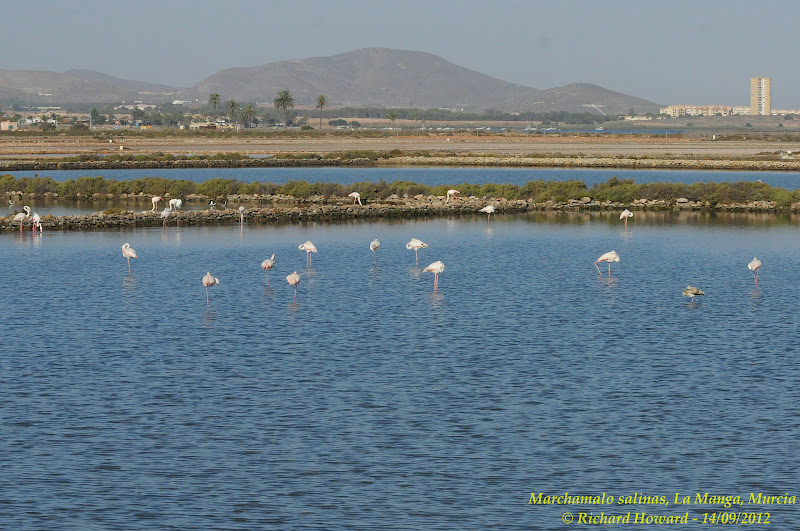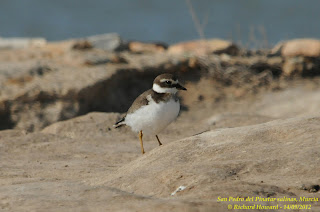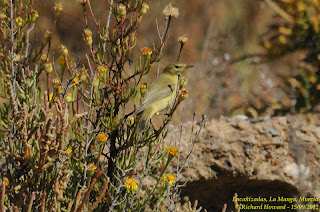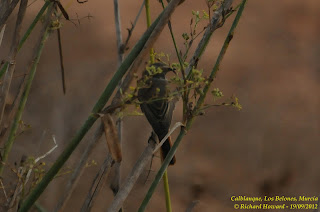Another summary, this time covering from Thursday 20th September to Sunday 23rd September. There’s not an awful lot of movement at the moment, but I have had some interesting sightings.
Thursday, 20th September 2012 - Marchamalo salinas & Cabo de Palos lighthouse garden
Today I went to the Salinas first thing. The water is once again being pumped into the Salinas and the water level is starting to rise noticeably – I presume due to the fact that it isn’t now so hot during the day, and so there is much less evaporation.
There were more waders today, with 25 Avocets, 9 Curlew Sandpipers, 21 Dunlin, 16 Little Stints, 4 Ringed and 3 Kentish Plovers, 17 Black-winged Stilts, 1 Common Sandpiper, 3 Redshank, 5 Spotted Redshanks and 5 Greenshanks.
A few of the newly arrived Avocets
Curlew Sandpipers and Dunlin
Dunlin
Friday, 21st September 2012 - Marchamalo salinas and Cabo de Palos lighthouse gardens
Today I had another morning roadside look at the Marchamalo salinas before going to work. Wader numbers were definitely down on yesterday, but I don’t know if this is due to there being more attractive feeding areas in some of the more interior lagoons now that the water level is rising. At my roadside spot, there were very few. What WAS noticeable was that a largish number of Greater Flamingos had arrived. I counted 87 in total, which included 16 juveniles. Of these 16, 6 were ringed, and from the ring-numbers I guess that they were all ringed in the same place – when I get the details back I can confirm that. On my way out from the Salinas, I noticed a small raptor sitting on the muddy field opposite, so I took the car to where I could get a better view. It sat in the field for about 5 minutes, and then took off passing over my car – a fine Merlin. And a couple of minutes later, a Sparrowhawk flew past in the opposite direction.
A couple of the few waders around - Dunlin
and a juvenile Curlew Sandpiper
Seen standing in a field opposite the salinas, a Merlin
The same bird, in flight
The 'punky' Blackbird at the lighthouse gardens
One of the few small migrants around, a Northern Wheatear
Again, a morning visit to Marchamalo, but the Flamingos of yesterday had gone leaving a core of just 33 birds of which only 3 were juveniles. Waders were again thin on the ground and the only birds of note were a group of 19 Slender-billed Gulls.
I had heard during the week of a sighting in some of the sierras of Cartagena, down towards Mazarron, of 3 Dotterel, so as it was still early I decided to go and investigate. I started out in totally clear-sky sunny warm conditions, in La Manga but by the time I reached the base of the sierra, there was low cloud hiding the peaks of the hills. As I was be walking approx. 10 km total (5 each way) I thought of this as a blessing as it would otherwise be too hot. Well after the hike, I decided I definitely need to do more exercise – 10km is no problem if it’s around the flat Mar Menor, but having to go up 250 metres is another thing entirely. I spent about 3 hours in total (1 ½ hours climbing, 1 hour looking for the birds and ½ hour coming back) – but had no luck with the Dotterel – in fact the only birds I saw were a Kestrel, a few Swallows, a flock of around 20 Bee-eaters lost in the fog which eventually burnt off, a few Thekla Larks and Dartford Warblers, and I heard a Green Woodpecker in one of the valleys.
Not too many birds seen in the sierras, this Dartford Warbler being one
Sunday, 23rd September 2012 - Marchamalo salinas Encañizadas La Manga
Another morning visit to Marchamalo, but with little change – water is still entering, and the muddy fringe at the side of the road where I normally see waders is now almost non-existent. Waders seen were all distant, around the edges of other lagoons. A single adult breeding plumage Grey Plover was new; Greater Flamingos settled around the 30 individuals mark, and I saw a couple of Spotted and 3 Common Redshank, and 3 Greenshank. On the ‘motas’ (walls of the lagoons) were a total of 14 Grey Herons.
I carried on to the 'Encañizadas' at the end of La Manga (a bit of a mistake as there was a ‘triathlon’ in progress, so much of the end of the 'strip' was cordoned off). When I eventually got there, there were signs of a bit of movement. There were a few (9) Cormorants on the outer islets, a small group of 7 Mallard, which I haven’t seen there since the spring, 45 Grey Herons 50+ Little Egret and 3 Spoonbills (definitely new in – one had a white ‘colour’ ring, but it was too far off to be able to read), and there were a few Swallows flying over south with at least one Red-rumped in amongst them.
But the bird of the day was definitely an Osprey, which I watched for over an hour. To start with it was just flying around overhead, obviously peering down intently into the water looking for some breakfast (and at the same time moving all the birds around). It had a couple of goes at dropping onto a fish without success, but on its third attempt it managed to catch quite a large one. It eventually managed to lift the fish out of the water – to be instantly attended by two juvenile Yellow-legged Gulls after a free meal. They harassed it for about 10 minutes, until eventually it dropped down onto a beach opposite me, but a long way off. I expected it to then demolish the fish, but after a few minutes (possibly just waiting till the coast was clear) it flew up again with the fish and flew inland towards San Pedro and San Javier, and I lost it to view south of San Javier.
The Osprey on one of its passes...
...stalling in midair prior to falling onto a fish...
...breakfast is caught, now to find somewhere to eat it...
...but the catch hadn't escaped the notice of some gulls































































